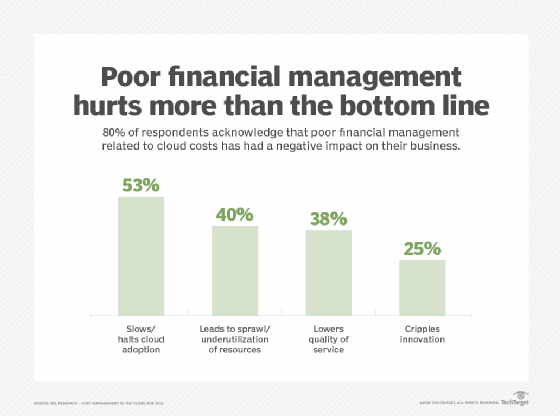
Jason Stitt - Fotolia
Lower your cloud bill with these AWS cost control tips
Without an AWS cost management strategy in place, cloud bills can spiral out of control. Explore these tools and best practices to optimize your AWS spending.
Enterprises that want to rein in their AWS cloud costs need to look deeper and across their cloud portfolio to better optimize their infrastructure.
Current cost optimization strategies are narrowly focused, with too much attention paid exclusively to the cost to run VMs, according to Owen Rogers, research vice president in cloud transformation at 451 Research. Enterprises need to factor in additional cost drivers, including networking, containers and other services higher up the stack.
However, doing this successfully has become increasingly complicated, especially as enterprises expand to other cloud platforms. In 2019, the number of line items for sale by the hyperscale cloud providers doubled, Rogers said, with 451 Research currently tracking 2 million product line items across Google, AWS, Microsoft, IBM and Alibaba. So, it's no surprise that complexity is the biggest challenge for enterprises looking for better AWS cost controls.
"Products, services and options change daily," Rogers said. "There's no way this complexity can be understood and optimized [just] using spreadsheets."
One of the latest tools to help reduce Amazon cloud costs is AWS Savings Plans. In exchange for certain financial commitments, enterprises will receive discounts of up to 72% compared to On-Demand pricing. "Enterprises will need to shift their thinking from the old AWS Reserved Instance model to Savings Plans, and this won't happen overnight," Rogers said. But this program provides more flexibility since IT teams don't need to be as granular in their predictions about future resource consumption.
And though AWS has this updated discount plan as well as a range of native bill management tools, it's not a one-stop shop for cost controls -- users can turn to third-party options too. Before you round out your AWS cost management strategy, review these tips on cost control best practices as well as the tools and services that can help lower your bill.

AWS cost management tools wrangle unwieldy expenses
AWS' consumption-based pricing model can be efficient for organizations, but their first cloud bill can come as a shock if they aren't careful.
This is where AWS cost control tools come into play. Amazon offers a variety of native cost management tools -- such as AWS Cost Explorer and AWS Budgets -- to assist in cost assessments and monitoring. For example, the Billing dashboard in the AWS Management Console provides a spending summary as well as month-to-date spending -- both relative and actual -- for each service, sorted by usage.
Take a closer look at the AWS-native options, their features and capabilities -- as well as some third-party tools -- to better understand your cloud bills.
Key considerations when selecting cost management tools
Enterprises need to make some critical choices when they assess their AWS cost management strategy. That starts with assessing their workload requirements, and the current deficiencies in their existing cloud management techniques. IT teams should focus on four specific areas:
- the organization's multi-cloud strategy;
- the size and scope of their AWS deployment;
- any regulatory requirements; and
- vendor and tool preferences.
Check out IT consultant Kurt Marko's full tip to go deeper on all four areas of analysis.
How to manage AWS data transfer costs
Unsuspecting IT teams can rack up serious bills if they move too much data out of AWS. That's why it's important to utilize practices that limit egress fees and cut down on data transfer costs.
For example, one strategy to get around unnecessary data egress fees is to implement Amazon CloudFront, a native content delivery network (CDN) service. If developers put Amazon's CDN service in front of their website, there is no charge to transfer data from Amazon EC2 and Amazon S3 to CloudFront. But users should note, there are fees to move data to customers.
Read the full tip from IT advisor Ofir Nachmani for more AWS cost control strategies to tackle transfer fees.
Tools and techniques to kick-start AWS cost reductions
AWS cost control depends on flexibility, accurate provisioning and responsible boundaries. Beware, small mistakes can lead to huge bills.
One cost reduction strategy is to refine your capacity planning. For most users, overprovisioning is almost unavoidable. However, with lower-cost instances and resource scheduling, manageable cloud bills may not be totally out of reach.
Learn more ways to refine your capacity planning and other strategies to cut unwanted charges -- including utilizing tags and infrastructure as code -- in this cost management tip by industry expert Kerry Doyle.





